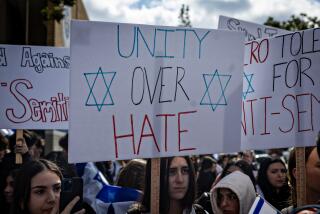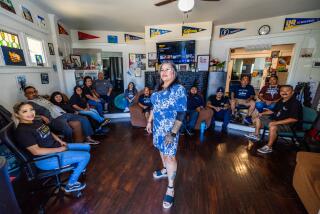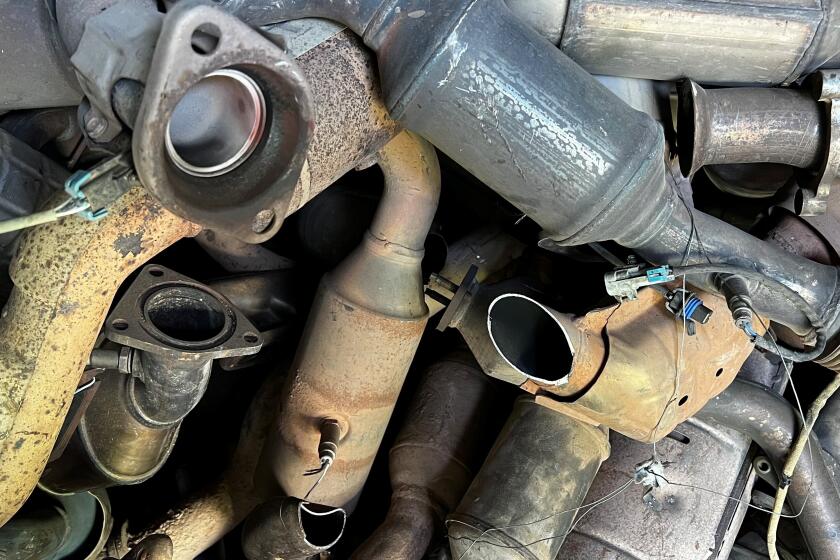Racial attacks by gangs rising, L.A. officials fear
- Share via
The headlines are among the most stark documenting gang violence. A Latino gang member, without saying a word, guns down a 14-year-old black girl standing on a sidewalk. A black gang member shoots a Latino toddler point-blank in the chest.
For the most part, though, the role racial animosity has played in gang crime has gone unexamined, largely undocumented in crime statistics and often tamped down by politicians and law enforcement officials anxious about inflaming tensions.
That changed this month when Los Angeles Mayor Antonio Villaraigosa, Police Chief William J. Bratton and L.A. County Sheriff Lee Baca all spoke with unusual candor of their concern that an increasing number of gang crimes appear to be born out of racial hatred. In a few instances, the Los Angeles Police Department has identified Latino gangs they say are indiscriminately targeting African American residents in what appear to be campaigns to drive blacks from some neighborhoods.
The acknowledgment by top officials, some activists say, has been a long time coming.
“What is happening is similar to small earthquakes taking place along a major fault line,” said Khalid Shah, executive director of Stop the Violence Increase the Peace Foundation, who said he has heard from numerous communities across the region reporting rises in racially motivated gang attacks. “Ultimately the danger is that there will be an explosion, particularly, I think, if we put our heads in the sand and try to act like this issue isn’t real.”
But getting a handle on how much gang violence is rooted in racism is difficult.
A Times analysis of Los Angeles Police Department statistics gives a partial picture, with numbers available only in cases in which a suspect’s race is known.
The tracking shows that the vast majority of the most serious gang crime remains intra-racial: Latinos attacking Latinos, blacks attacking blacks.
Last year there were more than 2,700 black-on-black or Latino-on-Latino incidents compared with slightly more than 500 interracial attacks.
Intent is often unknown
Harder to determine is intent. Without an admission of motivation, and often without even a suspect to question, knowing why a victim was targeted by a gang member is difficult: Was it skin color? Did they or family members have direct ties to gangs? Was it just bad luck? Mistaken identity?
In cases where gang-related homicide, aggravated assault or robbery crossed racial lines, LAPD tracking shows an 11% jump in incidents from 2002 to 2006; from 213 to 240 black-on-Latino attacks; and from 247 to 269 Latino-on-black attacks. As those interracial crimes rose, intra-racial gang attacks fell by 23%, from 3,577 to 2,780.
In a city where blacks and Latinos make up 96% of known street gang members and often live in proximity, it would not be unexpected that the two groups account for the vast majority of interracial gang crime.
“It should be no surprise to anyone that gang members have racist tendencies,” Bratton said. “Both street and prison gangs are constituted on race. But the reality is, most gang crime is motivated by greed and territory. Nevertheless, it is right that penalties are enhanced for hate crimes, and the LAPD will continue to aggressively investigate them.”
While citywide statistics show small bumps in interracial attacks, some neighborhoods are seeing troubling increases.
Of the 13 attempted murders involving gang members in the west San Fernando Valley since July, 10 involved black victims and Latino suspects, Lt. Tom Smart said. In many cases, the black victims were not affiliated with gangs, he said.
Still, Lt. Paul Vernon, an LAPD gang expert, said the citywide figures should be looked at in context.
Latinos and blacks are not equally represented in either the city’s population or documented gang membership. About 49% of Los Angeles residents are Latino and about 10% are black, according to the most recent Census Bureau estimates.
Of the city’s estimated 39,000 street gang members, the LAPD reports about 56% are in Latino gangs and about 40% in black gangs.
Of homicides, aggravated assaults and robberies committed by black gang members, about 2 in 10 are against Latinos. About 1 in 10 of the crimes committed by Latino gang members are against blacks.
Even with an uptick last year, gang crimes remain far below the historic highs of more than a decade ago.
Geography, identity and money remain driving forces in gang crime far more than race, law enforcement officials said.
“The vast majority of gang crimes are not based on hate, as in ‘I’m going to get you because of your race.’ They are based on ‘You are an outsider,’ ” Vernon said. “Now, certainly, race is one thing that can distinguish an outsider, but that doesn’t mean it is based on hatred of the race.”
Where violent crime takes place plays a major role in the relatively comparable number of interracial crimes committed by Latino and black gang members, despite blacks making up a much smaller portion of the population. A significant number of gang crimes occur in the Newton, Southwest, Southeast, and 77th Street divisions -- an area of the city that generated 37% of violent crime citywide last year and still has a large black population.
Those who follow gang crime caution that statistics currently kept by law enforcement make it difficult to determine specific motivations for most crimes. In hundreds of cases even the race of the suspect is unknown.
In some neighborhoods, however, racism is clearly a factor.
One recent case to draw national attention was the shooting death last month of Cheryl Green, 14. Green, who was black, was allegedly targeted by 204th Street Latino gang members because of her race.
Her shooting was one in a recent series of racially charged incidents in that neighborhood, where a decade ago the LAPD had won awards for cracking down on the 204th Street gang and a rival black gang.
Assistant Chief Earl Paysinger said the 204th Street gang isn’t like most other gangs in the city. “They have taken it to the extreme with utter hate. And they have become more extreme. Spraying ‘No N’s here’ on the walls,” he said.
Racial conflict is not new in Los Angeles, where long-simmering racial tensions and anger over police treatment of blacks fueled major riots in 1965 and 1992.
By the time Los Angeles erupted over the not-guilty verdicts in the Rodney G. King police beating trial, issues between white and black Los Angeles were already being overtaken by a massive demographic shift of Latinos into the region.
By the early 1990s, many South Los Angeles neighborhoods had become majority Latino, a population that has continued to grow in recent years.
Coexistence is strained
With that shift came changing gang boundaries. Alex Alonso, who studies gang territories in Los Angeles and runs the website streetgangs.com, said that though rival black gangs have traditionally had well-defined territories that do not overlap, Latino and black gangs had long coexisted on the same streets with little trouble.
As more and more areas changed from majority black to majority Latino -- and conversely as blacks moved into traditionally Latino areas such as Harbor Gateway and parts of the Valley -- open conflict broke out in some cases.
At the same time, Alonso said the underlying tensions were not openly talked about, with some politicians worrying that such dialogue might inflame racial divisions.
Gang violence in general, he said, has been a difficult topic for leaders hoping to promote their areas as good places to live.
He pointed to the situation in Highland Park, where the Avenues, a notorious Latino gang, in 1995 unleashed a six-year campaign to drive African Americans out of their predominantly Latino neighborhood.
Last summer, four of the gang’s leaders were found guilty in federal court of hate crimes. Three were sentenced to life in prison, and the fourth is scheduled to be sentenced Monday.
“In Highland Park no one wanted to discuss what was really going on,” Alonso said. “Who knows what would have happened if they had? Maybe something would have been done sooner.”
In the absence of admissions from suspects, local leaders have been quick to downplay race as motivation. Last summer, when three Latinos, including a 12-year old boy, were killed execution-style by black suspects in South Los Angeles, Villaraigosa urged residents not to jump to conclusions, although police said the victims had no gang ties and no known enemies.
“There is no information to believe that this is racially motivated,” he said at the time. The case is still under investigation.
Racism often downplayed
Fernando Guerra, a Loyola Marymount professor and director of the Center for the Study of L.A., said there has been little upside for politicians in talking about the racial overtones of gang violence. The instinct, he said, is to downplay racism as a cause, in part because “it’s not clear what the policy will be or even if there is a public policy that would work.”
One factor in racial street violence may be long-standing racial divisions in jails and prisons. Early last year , thousands of Latino and black inmates in Los Angeles County jails engaged in a series of fights over more than a week, leaving scores injured and two black inmates dead.
As felons go in and out of jails and prisons in the state with increasing frequency, some observers worry that the strict racial divisions learned behind bars are becoming internalized.
“Given the racial dynamics of violence in prison, it would be very scary if that got transferred onto the street,” said Cheryl Maxson, a UC Irvine professor who studies crime and street gangs.
Robin Toma, executive director of the Los Angeles County Human Relations Commission, called gangs a “serious problem” when it comes to hate-based crimes.
Last year, the county reported the first increase in hate crimes since 2001. But even with the jump, hate crime reports in 2005 were at their second-lowest level in the county since 1990.
And the raw numbers are still tiny in comparison with overall crime -- 69 incidents of documented gang hate crimes compared to tens of thousands of crimes reported countywide.
One step to better understanding the role of racism would be for law enforcement agencies to track and make available to researchers information about specific motivations in gang crimes when known.
“When you’re talking about gang-on-gang violence, you ask, ‘How much of that is part of normal gang conflicts over drugs and territory?’ ” Maxson said. “The question is: ‘What is the role of racial conflict when you think of gang conflict?’ ”
On the streets, though, Alonso said both black and Latino residents in the gang neighborhoods he regularly visits have little doubt. From their perspective, he said racially motivated gang attacks have “absolutely gone up.”
patrick.mcgreevy@latimes.com
Times staff writers Richard Winton and Evelyn Larrubia contributed to this report.
More to Read
Sign up for Essential California
The most important California stories and recommendations in your inbox every morning.
You may occasionally receive promotional content from the Los Angeles Times.












